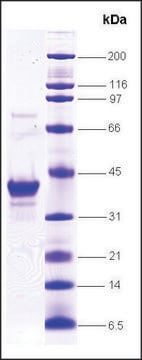ECAS9GFPPR
eSpCas9-GFP Protein
from Streptococcus pyogenes with mutations conferring enhanced specificity, fused with enhanced GFP, recombinant, expressed in E. coli, 3X NLS
Synonyme(s) :
eSpCas9-EGFP, eSpCas9-GFP
About This Item
Produits recommandés
Produit recombinant
expressed in E. coli
Pureté
≥90% (SDS-PAGE)
Forme
lyophilized powder
Conditionnement
pkg of 1 kit (3 components)
Gène reporter
GFP
Conditions d'expédition
wet ice
Température de stockage
−20°C
Catégories apparentées
Description générale
An N-terminally fused enhanced green fluorescent protein with an excitation peak at 488 nm and emission peak at 509 nm allows for visualization of transfected RNP complex in addition to utility in flow cytometry applications. The protein also contains three varied nuclear localization sequences postioned for optimal activity.
Application
- Functional Genomics
- Target Validation
- Genome Editing
- Fluorescence Microscopy
- Flow Cytometry
Caractéristiques et avantages
- Enhanced specificity compared to wild type Cas9
- Highly active
- Ready-to-inject/transfect
Conditionnement
pkg of 250 μg ( ≥1300 pmol)
Composants
- one vial of lyophilized eSpCas9-GFP recombinant protein
- one vial containing 1 mL of 1x dilution buffer
- one vial containing 1 mL of nuclease-free water with glycerol
Principe
Newly engineered eSpCas9 (1.1) enables the efficient targeted gene editing of established CRISPR systems with the benefit of reduced off-target effects. Point mutations (K848A/K1003A/R1060A) in the chromosome-binding motif of SpCas9, as described by Slaymaker, et al., provide higher on-target fidelity without loss of cleavage efficiency.
Reconstitution
Autres remarques
Check out our other MISSION® Cas9 Proteins at SigmaAldrich.com/CRISPRproteins
Informations légales
Code de la classe de stockage
11 - Combustible Solids
Certificats d'analyse (COA)
Recherchez un Certificats d'analyse (COA) en saisissant le numéro de lot du produit. Les numéros de lot figurent sur l'étiquette du produit après les mots "Lot" ou "Batch".
Déjà en possession de ce produit ?
Retrouvez la documentation relative aux produits que vous avez récemment achetés dans la Bibliothèque de documents.
Les clients ont également consulté
Articles
Validate CRISPR gene editing experiments easily with Sigma-Aldrich® T7E1 mismatch detection kit, ensuring successful editing.
Protocoles
Combine guaranteed sgRNAs with our comprehensive range of CRISPR products and tools, including Cas9 and delivery reagents, for efficient genome modification with higher specificity.
Notre équipe de scientifiques dispose d'une expérience dans tous les secteurs de la recherche, notamment en sciences de la vie, science des matériaux, synthèse chimique, chromatographie, analyse et dans de nombreux autres domaines..
Contacter notre Service technique
















